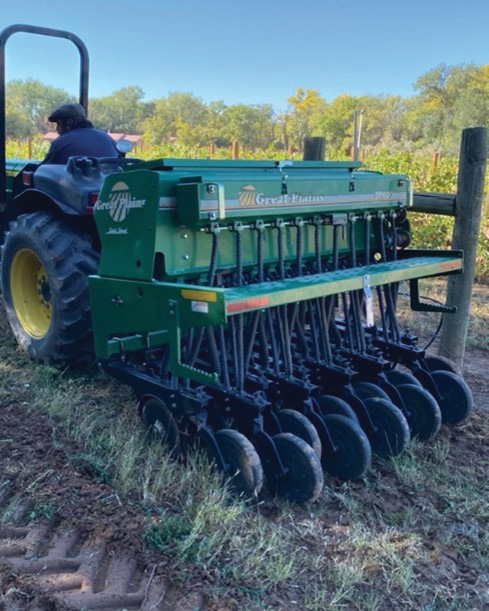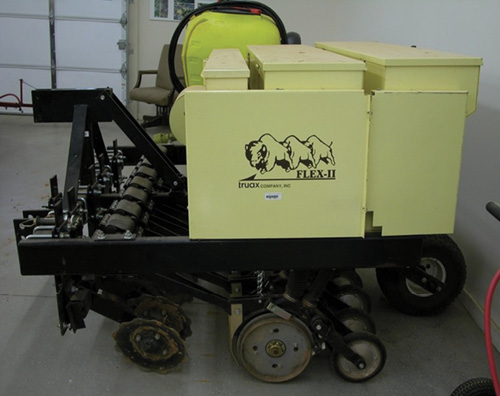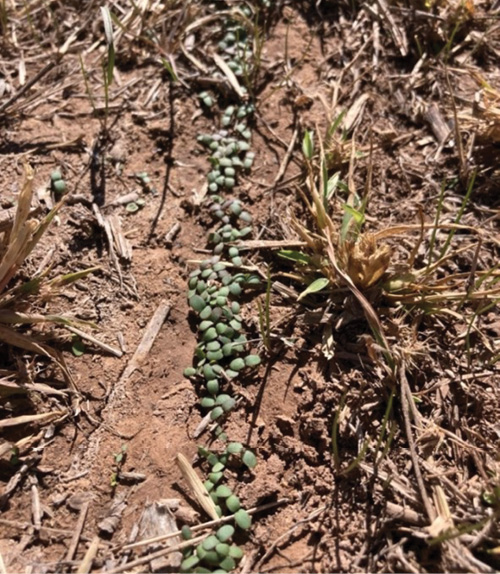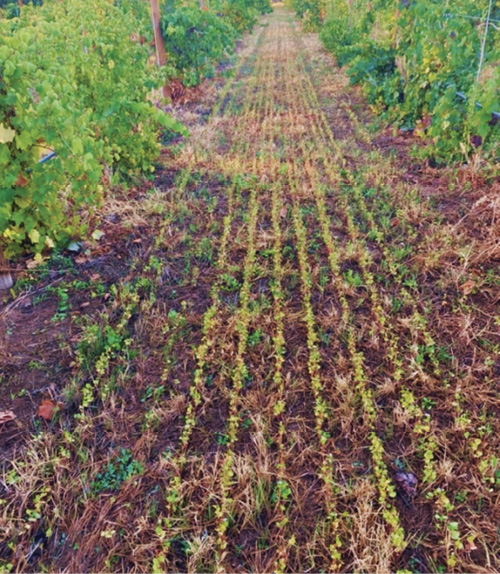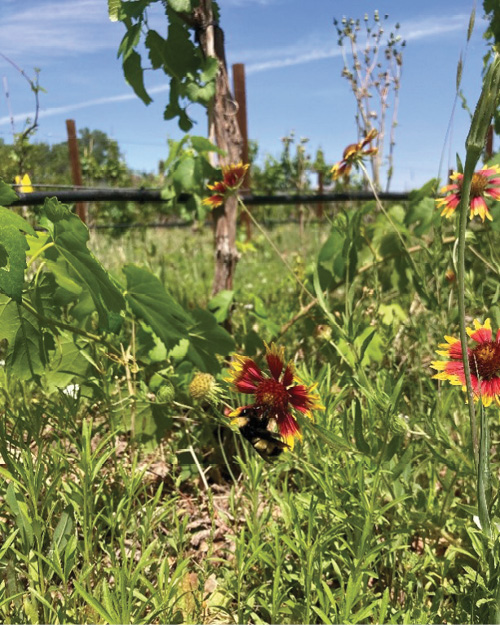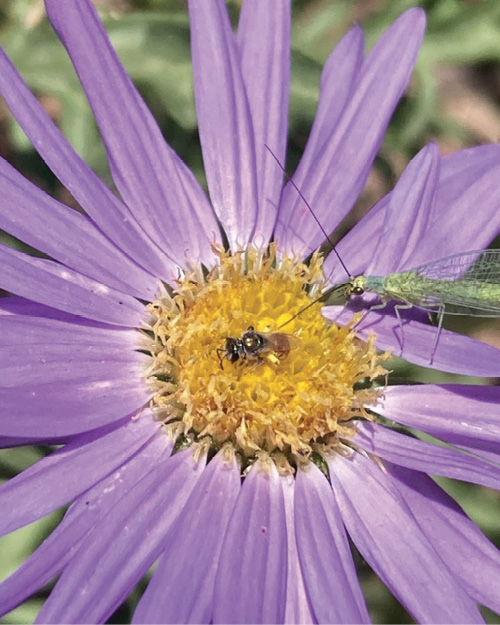Guide H-186
Miranda L. Kersten and Gill Giese
College of Agricultural, Consumer and Environmental Sciences, New Mexico State University
Respectively, former IPM Program Manager, Agricultural Science Center at Los Lunas; and former Extension Viticulture Specialist, Department of Extension Plant Sciences/Agricultural Science Center at Los Lunas, New Mexico State University. (Print-Friendly PDF)
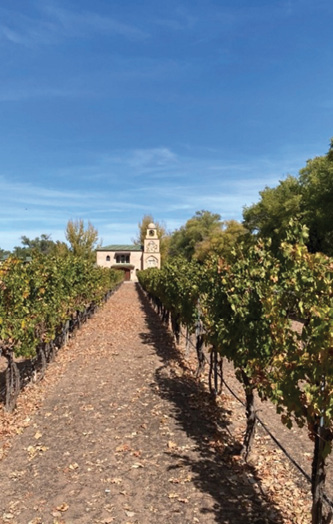
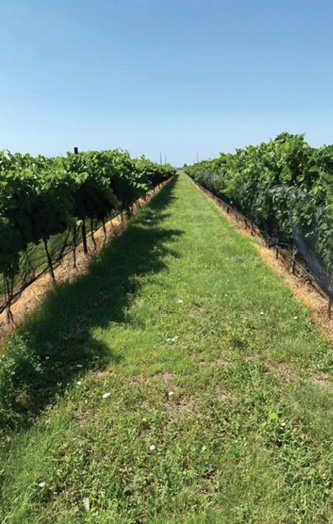
Figure 1. a. Conventionally cultivated vineyard inter-rows (Albuquerque, Bernalillo Co., NM) and b. primarily bermudagrass (Cynodon dactylon) ground cover inter-rows with herbicide-treated vine rows (Portales, Roosevelt County, NM).
Common New Mexico vineyard inter-row floor management consists of conventionally cultivated soil that is practically bare for most of the year (Figure 1a).
A substantial number of growers whose vineyards receive less than 20 inches of annual precipitation are reluctant to plant cover crops that might compete with vines for soil moisture. These exposed areas that are subjected to repeated cultivation are prone to wind and water erosion (Figure 2).
Cultivated soils release carbon that subsequently contributes to atmospheric warming due to the greenhouse effect of such gases. Repeated cultivation is detrimental to soil structure, reducing the soil’s water-holding capacity and suitability for plant growth and contributing to compaction. Finally, the exposed soil due to cultivation typically has elevated soil temperatures relative to vegetation covered soil that are likely detrimental to the native soil microbiome essential for soil health1.
Establishing and maintaining cover crops or native vegetation as ground cover in vineyards can reduce wind and water erosion, increase soil organic matter (positively impacting soil health), improve water infiltration and soil structure, reduce greenhouse gas emissions, suppress weeds, and increase biodiversity associated with possible improvement of berry composition in some cultivars at harvest2-5. Furthermore, cover crops provide a stable working “floor” to support human and mechanized vineyard operations and add aesthetic value to the vineyard (Figure 1b). These benefits align with grower concerns as surveyed in 2022 in New Mexico (Table 1). Based on the survey results, inter-row cover cropping is most likely to be adopted by New Mexico growers. This practice would mitigate soil erosion while enhancing pollinator habitat and improving soil health.
Figure 2. A conventionally cultivated New Mexico vineyard with evidence of wind erosion.
The use of cover crops in inter-rows requires additional management and additional expense of purchased seed, planters, repeated mowing, and in some cases judicial, targeted herbicide applications. Some cover crop species can compete with grapevines for water and nutrients, causing possible impacts on pest and disease occurrence, vine size, yield, and berry composition6. However, the overall benefits of cover crops often outweigh the negatives.
For more information on cover crops in New Mexico, see NMSU Extension Guide A-150, Principles of Cover Cropping for Arid and Semi-Arid Farming Systems (https://pubs.nmsu.edu/_a/A150/) and NMSU Extension Circular 704, Using Cover Crops in New Mexico: Impacts and Benefits of Selecting the Right Crops (https://pubs.nmsu.edu/_circulars/CR704/).
|
Table 1. Grower self-described vineyard floor management schemes, level of concern, and desired vineyard cover crop benefits, New Mexico, 2022. Of the nine respondents, current floor management strategies include cultivation (1), bare ground (5), and perennial ground cover (3). |
||||||||
|
|
Soil Health | Erosion Control | Water | Grape Quality | Pests, Insects, Birds | Beneficial Insect Habitat | Soil Compaction |
Working Platform |
|
Major Benefits |
3 |
5 |
1 |
1 |
1 |
4 |
2 |
2 |
|
Minor Benefits |
2 |
0 |
2 |
1 |
1 |
2 |
1 |
2 |
|
Growers see benefits in cover crop use |
5 |
5 |
3 |
2 |
2 |
6 |
3 |
4
|
|
Growers see benefits in cover crop use (%) |
55% |
55% |
33% |
22% |
22% |
66% |
33% |
44% |
Establishing Inter-row Cover Crops
Seed Selection. When selecting a cover crop seed mix, site conditions, including soil type and moisture, weed pressure, growing zone [USDA plant hardiness zones, which can be found at https://planthardiness.ars.usda.gov], previous farming history, and seasonal timing should be considered along with seeding goals.
For example, if the goal is to provide a pollinator and beneficial insect habitat, mixes should include a diversity of plants that bloom throughout the growing season. These mixes often include annual and perennial species. Annual plants tend to cost less than perennials, are relatively quick to establish, produce flowers the year of planting, and are easily rotated with other plantings. Perennial plants can take longer to establish but offer additional benefits of being lower maintenance once established, coming back every year, and many can survive on less water relative to annual species. Both annual and perennial plants can attract and support diverse groups of beneficial insects. Depending on the goal, many different species can be planted for ground cover. Some examples of plants that can be used for cover vegetation for New Mexico vineyards include:
- Annuals
- Cereal grains, such as barley (Hordeum vulgare), rye (Secale cereale), winter wheat (Triticum aestivum), sesame (Sesamum indicum), oats (Avena sativa), and triticale (xTriticosecale)
- Daikon radish (Raphanus sativus var. longipinnatus)
- Winter camelina (Camelina sativa)
- Perennials
- Alfalfa (Medicago sativa)
- Balansa clover (Trifolium michelianum)
- Grasses, such as blue grama (Bouteloua gracilis), buffalograss (Bouteloua dactyloides), sideoats grama (Bouteloua curtipendula), western wheatgrass (Pascopyrum smithii), and sand dropseed (Sporobolus cryptandrus)
- Commercially available ‘pollinator mixes’ blends of annual and perennial wildflowers. Work with the seed company to ensure that the selected mix has a reasonable chance of success at your site and will meet your needs.
Each of these species has benefits and drawbacks. For example, alfalfa can thrive in New Mexico with additional irrigation and can be used to incorporate nitrogen into vineyard soils. However, it can be hard to control or eradicate once established and competes excessively with grapevines. Although it can survive up to 5 years (without supplemental irrigation, alfalfa requires substantial water, 20 to 40 inches per year for maximum yields7). It is strongly recommended to work with a seed company to formulate a custom blend specifically adapted and recommended for your site.
For example, a successful custom wildflower seed mix planted at the Fabian Garcia Agricultural Science Center (ASC) in Las Cruces, NM, contained 13 plant species. The main (~15% each) three species were California poppy (Eschscholzia californica var. orange), blue flax (Linum lewisii), and greenthread (Thelesperma filifolium). However, this custom mix was more expensive compared to other commercially available pollinator seed mixes.
Planting
Figure 3. Examples of no-till seeders. Winter camelina (Camelina sativa) inter-row seeding in the vineyard at Los Lunas Agricultural Science Center, Los Lunas, NM (a, left). A relatively narrow-bodied and heavy seeder (b, above), that will pass between vine rows, is compatible with many standard 3-point hitch systems, will penetrate existing ground cover and is equipped with three seed boxes to accommodate a range of seed including small clover and brassica seed, larger seed of cereal grains, and irregular ‘fluffy’ seed of most native flowering species.
Site preparation. Prior to planting, weeds should be managed by mowing or light disking if a no-till seeder is not available and the soil is crusted and compacted. To greatly increase the chance of successful planting, provide irrigation to the seeded area, maintaining consistent soil moisture for the first 6-8 weeks. This will increase germination and enhance seedling survival. A weed control plan should be in place because weeds will likely germinate and grow in the irrigated area.
Seeding. Several methods exist for seeding, such as broadcast seeding and no-till seeding. Seeds can be broadcast with a hand-operated ‘Cyclone’ seeder or with a broadcast seeder attached to a tractor or ATV. With broadcasting, seed should be applied in two directions to ensure uniform coverage across the site. Following application, seed can be lightly raked in by hand for smaller areas or lightly harrowed on larger areas to achieve optimal seed-to-soil contact. The area can then be rolled to moderately compress the soil and increase seed contact with the soil. We recommend talking to the seed company for recommended seeding rates.
No-till drills disturb the soil much less compared to other mechanical methods of planting and advantageously plant through existing ground cover, organic matter, or crop residue (Figure 3). No-till drills cut a shallow furrow into the ground, drop seeds, and then have rollers that press the seed into the soil. For example, at Los Lunas ASC, winter camelina (Camelina sativa) planted in the fall through existing cover and subsequently flood irrigated to encourage germination provided a successful stand with minimal soil preparation (Figure 4).
Timing of Planting. Native seeds can be planted in spring (March-mid-June) or fall (mid-August to late October). A fall planting allows seeds to experience natural conditions for those species that require stratification (exposure to cold) or scarification (physical degradation of the seed coat) to germinate. Timing also varies depending on the latitude and altitude of the site and its historical rainfall patterns.
Issues with Planting. Weeds can dominate and outcompete seeded species. These can be mitigated with cultivation or appropriate herbicide application. Planting on non-irrigated lands is not recommended due to the high cost of seed and additional labor. Such plantings typically fail in the Southwest when relying on precipitation alone8. However, it can be conditionally recommended to time seeding to take advantage of spring or summer monsoon rains.
Figure 4. Winter camelina juvenile plants germinating through existing ground cover residue, approximately two weeks after seeding.
Pollinators and Beneficial Insects
Although some insect species can be detrimental vineyard pests, more species contribute to many different ecosystem services, including decomposition and nutrient cycling, seed dispersal, food for vertebrate animals, pollination, and natural pest control. However, here we focus on pollinators and natural enemies (predators and parasitoids) as beneficial insects.
New Mexico’s pollinator population is one of the most diverse in the United States with over 1,000 native bee species and over 350 species of butterflies9,10. However, pollinator populations are in decline due to habitat loss, chemical use, and pressure from pests and diseases11. Cover crops can increase pollinator habitat resources (food and nesting sites) needed for the conservation of these species. Although grapes do not require pollination to set fruit, creating a system that supports cover crops and provides diverse agro-ecosystems is important for increasing sustainability. Sustainability, as used here, indicates an ecosystem’s resiliency and stability. Resiliency is the ability to “bounce back” to functional health when normal processes have been disrupted. Stability is the ecosystem’s ability to perform its functions despite wide variation in environment and human mismanagement (adapted from Weil and Brady in Elements of the Nature and Properties of Soils, 4th edition, 2019). Cover crops that support beneficial insects may also increase biological control of nematode and insect pests in vineyards12, 13. Flowering cover crops can result in a greater diversity and abundance of bees than weedy vegetation. However, native plant species may be preferable as cover crops in this region because irrigated non-native cover crops that are poorly adapted to the soil and rainfall patterns, such as buckwheat (Fagopyrum esculentum), are difficult to establish and maintain and can also increase pest populations, such as leafhoppers14. Furthermore, native plant species often support more native pollinators than do non-native plant species, and once established, they typically require less maintenance and resources, especially irrigation water.
Planting pollinator habitats support natural enemy populations that can help with managing pest populations, such as aphids, leafhoppers, and leafminers. These beneficial insects have three broad sets of requirements to complete their life cycles: floral resources, shelter, and supplementary resources, like alternative prey and nesting materials15. Grapes are not insect-pollinated, but vineyards can still play a substantial role in biodiversity conservation with pollinator-friendly management. Honeybees are frequently observed visiting grape flowers in the spring at NMSU’s Los Lunas Agricultural Science Center, but it is unclear how much of a resource they provide. Honeybees, yellowjackets, and bumble bees also feed on damaged grapes in the fall and can be a nuisance to hand harvesting.
Figure 5. An American bumble bee (Bombus pensylvanicus) on a blanketflower (Gaillardia aristata) (a, left); a sweat bee and green lacewing on a Tahoka daisy (Machaeranthera tanacetifolia) in a vineyard (b, right)
Several studies have shown that cover vegetation in vineyard inter-rows can provide the floral resources, shelter, and alternative prey that support insect populations (Figure 5). This vegetative cover also increases biological control of pests by providing a habitat for natural enemies of pests that occur in grapes. Additionally, studies in Washington show that native plants and habitation restoration in wine grapes benefit butterfly habitat16.
In preliminary surveys, 11 genera of bees were collected through sweep netting winter camelina (Camelina sativa) at flowering in spring 2022 at NMSU’s Los Lunas Agricultural Science Center vineyard (Valencia County) and 16 genera of bees from pan traps throughout the summer at the Pueblo of Santa Ana vineyard (Sandoval County). Ten groups of natural enemies were present in sweeps in the winter camelina – spiders and parasitoid wasps were most prevalent, but syrphid flies, ladybeetles, Collops beetles, nabid bugs, assassin bugs, minute pirate bugs, lacewings, and big-eyed bugs were also present.
Insect sweeps at Lescombes’ Vineyard (Hidalgo County, NM) produced nine natural insect enemy groups present in a Daikon radish (Raphanus sativus) cover crop – minute pirate bugs, parasitoid wasps, and big-eyed bugs most prevalent, spiders, syrphid flies, ladybeetles, Collops beetles, nabid bugs, and lacewings, and eight natural enemy groups in three replicated plots (mostly weedy, native vegetative cover) – parasitoid wasps, Collops beetles, and big-eyed bugs most prevalent (Table 2). No bees were collected in these surveys.
Establishing and maintaining vegetative vineyard ground cover may initially be more cost and time intensive relative to conventional cultivation. However, finding a vegetative ground cover that provides advantages to vineyards while also providing ecosystem services is possible, and provides overall benefits to the environment.
|
Table 2. Results from insect sweeps at Lescombes’ Vineyard, Hidalgo Co., NM. Sweeps occurred in Daikon |
||||||||||
|
Date |
Cover | Parasitoid Wasp | Spiders | Syrphid | Ladybeetle | Callops | Nabid Bug |
Minute Pirate Bug |
Lacewing |
Big-eyed Bug |
|
5/26/2022 |
Native Vegetation |
4.33 |
2.33 |
0.00 |
0.33 |
2.33 |
0.33 |
1.67 | 2.00 | 2.33 |
|
6/6/2022 |
Daikon Radish |
6 |
5 |
0 |
4 |
2 |
5 |
16 | 3 | 8 |
|
6/6/2022 |
Native Vegetation |
0.33 |
0.33 |
0.00 |
0.67 |
0.33 |
0.33 |
0.33
|
0.00 | 1.00 |
|
8/3/2022 |
Native Vegetation |
1.00 |
0.33 |
0.00 |
0.00 |
0.33 |
0.00 |
0.33 |
0.00 |
0.00 |
Resources
Ghimire, R., R. Sallenave, and A. Smith Muise. 2022. Using Cover Crops in New Mexico: Impacts and Benefits of Selecting the Right Crops. NMSU Cooperative Extension Service, Circular 704. https://pubs.nmsu.edu/_circulars/CR704/index.html
Helwi, P. 2021. Vineyard Soil Management Throughout the Season. Texas A&M AgriLife Extension. https://www.txwines.org/wp-content/uploads/2021/05/Vineyard-Soil-Management-Throughout-the-Season.pdf
Idowu, J. and K. Grover. 2014. Principles of Cover Cropping for Arid and Semi-air Farming Systems. NMSU Cooperative Extension Service, Guide A-150. https://pubs.nmsu.edu/_a/A150/
Lee-Mader, E., A. Stine, J. Fowler, J. Hopwood, and M. Vaughan. 2015. Cover Cropping for Pollinators and Beneficial Insects. SARE Outreach Bulletin. https://www.sare.org/resources/cover-cropping-for-pollinators-and-beneficial-insects/
Kersten, M. L. and G. Giese. 2022. Grape IPM in New Mexico. NMSU Cooperative Extension Service, Circular 705. https://pubs.nmsu.edu/_circulars/CR705/index.html
Wolf, T.K. and G. Giese, 2020. Floor Management Strategies for Virginia Vineyards. Publication SPES-209, Virginia Cooperative Extension, https://www.pubs.ext.vt.edu/content/dam/pubs_ext_vt_edu/spes/spes-209/SPES-209.pdf
References
- Jansson, J. K., & Hofmockel, K.S. (2020). Soil microbiomes and climate change. Nature Reviews Microbiology, 18, 35-46. https://doi.org/10.1038/s41579-019-0265-7
- Guerra, B. and K. Steenwerth. (2012). Influence of floor management technique on grapevine growth, disease pressure, and juice and wine composition: A review. American Journal of Enology and Viticulture, 63(2), 149-164.
- Garcia, L., Celette, F., Gary, C., Ripoche, A., Valdés-Gómez, H., & Metay, A. (2018). Management of service crops for the provision of ecosystem services in vineyards: A review. Agriculture, Ecosystems and Environment, 251, 158–170.
- Winter, S., Bauer, T., Strauss, P., Kratschmer, S., Paredes, D., Popescu, D., Landa, B., Guzmán, G., Gómez, J.A., Guernion, M., Zaller, J.G., & Batáry, P. (2018). Effects of vegetation management intensity on biodiversity and ecosystem services in vineyards: A meta-analysis. Journal of Applied Ecology, 55, 2484-2495.
- Pausic, A., Tojnko, S., & Lesnik, M. (2021). Permanent, undisturbed, in-row living mulch: A realistic option to replace glyphosate-dominated chemical weed control in intensive pear orchards. Agriculture, Ecosystems & Environment, 318, 107 502.
- Abad, J., Hermano de Mendoza, I., Marin, D., Orcaray, L., & Gonzaga Santesteban, L. (2021). Cover Crops in Viticulture. A Systematic Review (2): Implications on Vineyard Agronomic Performance. OENO One 2021, 2, 1-27. https://oeno-one.eu/article/view/4481
- Henson, B. (2008). Alfalfa. University of California, Drought Management. Retrieved September 24, 2023, from https://ucmanagedrought.ucdavis.edu/alfalfa.cfm
- Dreesen, D.R., & White, K.L. (2015). Establishment of Pollinator Plants by Direct Seeding in Floor Irrigated Fields at the Los Lunas Plant Materials Center (USDA Final Study Report). Retrieved from https://www.nrcs.usda.gov/plantmaterials/nmpmcsr12601.pdf
- Weaver, J.R. (2020). North American Bee Distribution Tool. U.S. Fish and Wildlife Service, Albuquerque, NM.
- Cary, S.J., & Toliver, M.E. (2022). Butterflies of New Mexico: Introduction and Index. Retrieved from https://peecnature.org/butterflies-of-new-mexico/
- Potts, S.G., Biesmeijer, J.C., Kremen, C., Newumann, P., Schweiger, O., & Kunin, W.K. (2010). Global pollinator declines: Trends, impacts, and drivers. Trends in Ecology and Evolution, 25, 345-353.
- Irvin, N.A., Hagler, J.R., & Hoddle, M.S. (2018). Measuring natural enemy dispersal from cover crops in a California vineyard. Biological Control, 126, 15-26.
- Saenz-Romo, M.G., Veas-Bernal, A., Martinez-Garcia, H., Ibanez-Pascual, S., Martinez-Villar, E., Campos-Herrera, R., Marco-Mancebon, V.S., & Perez-Moreno, I. (2019). Effects of ground cover management on insect predator and pests in a Mediterranean vineyard. Insects 10, 421, 1-16.
- Irvin, N.A., Bistline-East, A. and Hoddle, M.S. (2016). The effect of an irrigated buckwheat cover crop on grape vine productivity, and beneficial insect and grape pest abundance in southern California. Biological Control, 93, 72-83.
- Ollerton, J. (2021). Pollinators & pollination: nature and society. Pelagic Publishing, Exeter.
- James, D.G., Seymour, L., Lauby, G., & Buckley, K. (2015). Beauty with benefits: Butterfly conservation in Washington State, USA, wine grape vineyards. Journal of Insect Conservation, 19, 341-34.
This material is based upon work that is supported by the National Institute of Food and Agriculture, U.S. Department of Agriculture (USDA) under award number 2020-38640-31523 through the Western Sustainable Agriculture Research and Education program under project number WRGR21-005. USDA is an equal opportunity employer and service provider. Any opinions, findings, conclusions, or recommendations expressed in this publication are those of the author(s) and do not necessarily reflect the view of the U.S. Department of Agriculture.

Miranda Kersten is a Senior Program Specialist with the urban integrated pest management (IPM) program at NMSU’s Agricultural Science Center in Los Lunas. Her work focuses on pollinator and beneficial insect conservation, monitoring beneficial insects across urban landscapes, and managing IPM research projects.

Gill Giese is the Extension Viticulture Specialist and Assistant Professor at NMSU. He earned his Ph.D. at Virginia Tech, and has worked as a commercial winemaker and viticulture/enology instructor. His applied research and Extension work focuses on variety/rootstock evaluation, mitigation of frost/cold damage, soil issues, insects and nematodes, and trellising options to optimize grape yield and berry composition in New Mexico and the arid Southwest.
To find more resources for your business, home, or family, visit the College of Agricultural, Consumer and Environmental Sciences on the World Wide Web at pubs.nmsu.edu/
Contents of publications may be freely reproduced for educational purposes. All other rights reserved. For permission to use publications for other purposes, contact pubs@nmsu.edu or the authors listed on the publication.
New Mexico State University is an equal opportunity/affirmative action employer and educator. NMSU and the U.S. Department of Agriculture cooperating.
September 2024 Las Cruces, NM



